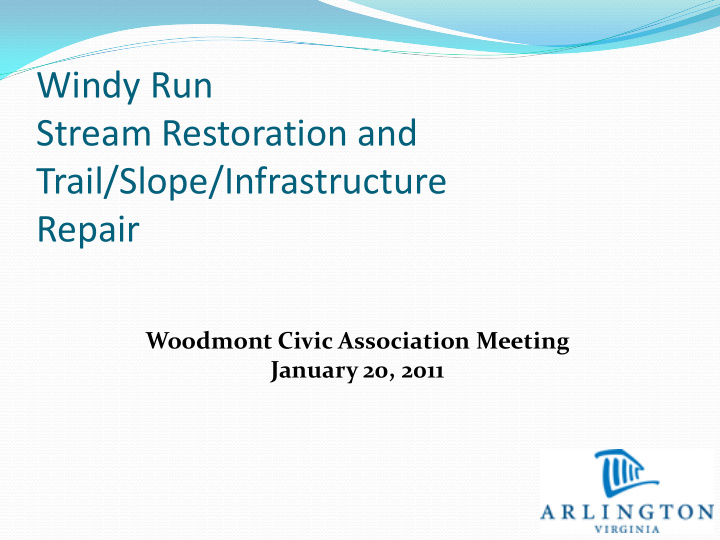



Windy Run Stream Restoration and Trail/Slope/Infrastructure Repair Woodmont Civic Association Meeting January 20, 2011
Stormwater Challenges Existing Development. Most of Arlington was built before stormwater regulations existed. County streams are heavily impacted. New state and federal regulations to reduce water pollution. Aging Infrastructure. More than half of the storm sewer network is over 50 years old. System Capacity. Climate change. Climate models predict heavy rainfall events could increase sharply.
Stormwater Strategy – in brief Maintain & replace stormwater infrastructure Improve existing, and add new, stormwater treatment facilities Stormwater controls for new development Reduce risks from flooding Restore stream corridors Implement urban housekeeping best practices (such as street sweeping) Outreach, education, and monitoring
Stormwater Master Plan Update Stormwater Master Plan (1996) and Watershed Management Plan (2001) will be updated and combined into a comprehensive Master Plan. Storm Sewer Capacity Analysis to study the County's current storm sewer pipes. County-wide stream inventory to assess stream conditions and prioritize stream restoration projects. Watershed retrofit plans to identify locations where stormwater treatment facilities can be added to help slow down and filter stormwater runoff.
Windy Run watershed Land Use: 75% single-family residential Windy Run 6% medium/high density residential 317 acres (0.5 square miles) 16% public/semi-public (parks, schools, etc.) 2005 impervious cover = 36% <1% commercial/industrial County-wide 2005 impervious cover = 41% 3% ‘vacant’ land
Stream erosion, tree damage, and habitat degradation
Stream erosion near sanitary sewer pump station
Exposed sewer lines
Trail and slope damage
Failed storm sewer endwall & gully erosion
Restoration/Repair Plan
Windy Run stream restoration design elements Create ‘active’ or ‘bankfull’ channel Floodplain benches Retain existing stream alignment Grade controls Vegetation for stabilization and habitat
Grade Control/Habitat Creation Floodplain Connection Photo of Donaldson Run
Infrastructure Repair Re- align sanitary sewer to eliminate ‘hanging’ crossing Stabilize bottom and top of slope below trail with stacked stone Extend storm sewer under trail to connect to stream at stabilized outfall Repair failed storm sewer endwall & gully Reconfigure two other existing storm sewer outfalls for improved stream connection/stability
Trees
Trees ~17 trees >15” diameter to be removed Many already threatened or compromised 11 of 17 with condition rating below 70 out of 100 5 of 17 with condition rating below 60 43 trees overall Trees with reasonable survival chance will be saved, and some design adjustments may be made Minimum tree replacement = 68 trees
Planting Plan Canopy and understory trees Shrubs and native plants Carya glabra Pignut Hickory Alnus serrulata Common Alder Carya tomentosa Mockernut Hickory Euonymus americanus American Strawberry Bush Nyssa sylvatica Black Gum Viburnum dentatum Arrowwood Prunus serotina Black Cherry Hamamelis virginiana Witchhazel Quercus alba White Oak Quercus coccinea Scarlet Oak Elymus riparius Riverbank Wild Rye Dichanthelium clandestinum Deertongue Grass Eupatorium coelestinum Mistflower Leersia virginica White Grass Eupatorium fistulosum Hollow Joe-pye-weed Rudbeckia hirta Black-eyed Susan Glyceria striata Fowl Manna Grass Sanicula canadensis Black Snakeroot Helianthus decapetalus Thin-leaved Sunflower Invasive plant management English ivy, porcelain berry, privet, winged euonymous, creeping euonymous, bush honeysuckle, Japanese honeysuckle, wineberry VOLUNTEERS NEEDED!
Next Steps Complete design and specifications Acquire easement (1) Issue construction solicitation Anticipated construction start – depends upon easement acquisition (Fall?) Estimated construction duration – 2 months Trail will be closed for most of construction period
Questions, comments, more information Jason Papacosma (703) 228-3613 jpapacosma@arlingtonva.us Project website: www.arlingtonva.us - click on ‘watershed management’
Recommend
More recommend